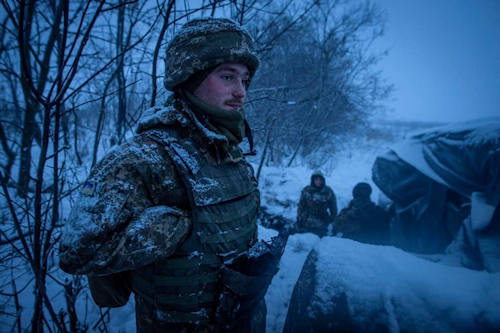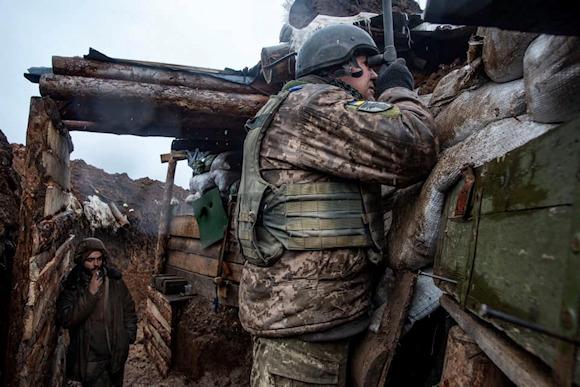"The organizational, economic, means and training superiority of the Russian forces is such that Ukraine would be forced to surrender or undergo a real debellatio before the summer, if attacked in February". A reader - who is highly esteemed by the way - hit the button with me for almost an hour to prove this axiom to me. Too bad that this perfect theory has a very serious original sin: it does not take into account the context, that is, that two armed forces and not even two country systems will not face each other in the cosmic void, but in a territory that is twice as large as Italy where the Russian-speaking community - whose ideal proximity to Moscow we reasonably doubt - it represents less than 20% of the residents.
It always ends in a siege ...
Let's start by observing how in the wars fought in Europe, from 1991 to today, we have always witnessed an enormous imbalance of forces between the aggressor and the attacked: the Yugoslav army - second in continental Europe only to France - against Bosnia- Herzegovina completely devoid of an army, Serbia-Montenegro against Kosovo - defended only by its partisans -mujahideen, a robust regional powerhouse1 like the Russian Federation against small states like Moldava and Georgia which together do not reach 5% of the Russian population and have less than 1% of Moscow's military budget. However, that the strongest - even when much stronger - always manages to prevail is a paradigm falsified by history, which for many of us born before 2000 is only the consolidation of the news.
To give an example, the Bosnian Serbs - with the active support of Belgrade - reached out to two thirds of the Bosnian territory, but had to lock up and, ultimately, put under siege almost all the cities not inhabited exclusively by their ethnic group. . We remember the tragic cases of Dubrovnik / Ragusa (forty thousand inhabitants, gripped in the grip of Karadzic and Gen. Mladic in 1992 for eight months), Mostar (one hundred thousand inhabitants, besieged for nine months in 1993) and Sarajevo (two hundred thousand inhabitants, besieged for 1.425 days from April 1992 to February 1996), costing tens of thousands of deaths and hundreds of thousands of wounded and maimed. To lay siege to Sarajevo alone it was necessary to employ a sixth of the land armed forces of the People's Republic of Yugoslavia. In the end, after so much effort, they also lost the war ...
Mom, I found a metropolis!
The context - in a possible Russian-Ukrainian conflict - is constituted by a network of cities and their inhabitants who - only to be very ignorant and presumptuous - we can assume that they await the Russians as liberators and that they represent many potential Donbass.

Twenty kilometers from the border with Ukraine, the attacking Russian army will immediately find the ... wild boar, namely Kharkiv (photo), former capital and second most populous city of the Ukrainian nation, with two million inhabitants - ten times Sarajevo, to understand each other - and a metropolitan area extended for 350 square kilometers, that is double that of Milan and almost three times that of the Bosnian capital. Over 55% of Kharkiv's inhabitants speak Ukrainian as their first language, while Russian speakers - just over 40% - are overwhelmingly well integrated and did not turn against Ukraine even during the chaotic spring of 2014. a special mention is the fact that 2% of the residents are ethnically Jewish, which leads to special attention from Israel. We do not imagine Jerusalem inattentive in case of bombings or other ...
You have to besiege it, there is no way ...
Of course, you can close Kharkiv in a pocket, aiming only to advance towards the Dnieper and decide to deal with it later, but it is not wise to do: in addition to dangerously lengthening the supply lines, you leave behind a huge black hole, on which Kiev and the West can easily pour aid, fighters and armaments, but above all build the myth of the "martyr city". So either the people of Kharkiv welcome you waving handkerchiefs and Russian tricolor flags - as likely as the election of a female pope - or you are in up to neck trouble, because you will be forced to use a substantial part of your strength to tighten in a vice the former Ukrainian capital and its huge territory.
Speaking of territory, Kharkiv is not a concrete block built by Stalin and it is not located in a desert. It is not a concrete block because it is a city of art and culture and one of the largest university cities in Europe, with tens of thousands of students from five continents, has two famous cathedrals (the Dormition and the Annunciation) and one series of important museums and theaters. Can Putin think of razing it to the ground with impunity as he did with Grozny, in Chechnya? Then, the city and the metropolitan area of Kharkiv are certainly not a cathedral in the desert: all around there are, in fact, numerous centers with a population varying between 20 and 50 thousand inhabitants, to understand the size of Mostar and Dubrovnik, which you can close in many small pockets but you have to, God forbid, take it by hook or by crook.
Finally, even assuming that with the help of the special forces the Russians manage to occupy strategic buildings in the center of Kharkiv, the city will still be subdued and normalized, which may require - I remember: two million inhabitants! - the bulk of the forces currently deployed around the Ukrainian borders, as well as a huge bloodbath. Keeping the proportions with the Sarajevo case, we could imagine over one hundred thousand dead, of which one fifth or one sixth among the uniformed men, mercenaries and personnel of the Russian occupiers. All this, to travel thirty kilometers inside the Ukrainian territory and occupy a symbolic city!
The very expensive price of the taking of Kharkiv
How long could the siege of Kharkiv last? Well, let's put it this way: it will depend on how quickly the Russians will have to get rid of that pocket and those roughly two million hostile people behind their ground forces.

Even if Western sanctions are bearable in the event of a mere crossing of the border, the side effects of the campaign to conquer and subjugate the former Ukrainian capital will force the Europeans - forced by Uncle Sam - to impose the most drastic sanction against the Russian Federation. : the blocking of the transit and trade of gas and other hydrocarbons to Europe, replacing them with that of Qatar, Canada and the United States itself. We are talking about two thirds of exports, the main sector of employment and the first source of valuable currencies in Russia.
And after Kharkiv?
Will the rest of the invasion, once the former Ukrainian capital be taken, be a piece of cake? Not at all: what we have seen is only the appetizer, even if already of indefinite duration and with a mortality among the Russian military of more than ten years of Soviet invasion of Afghanistan. Aside from the relative ease of advance into the uninhabited countryside, any major city will carry the same risks and costs as Kharkiv and will require a proportionate effort.
Once they arrive in Kiev, they will find a city with an area, an orography and a number of residents comparable to those of Rome (as well as many important UNESCO sites that will make every offensive look like an ISIS operation in Palmyra) and , to take it, they will have to field a force and expect costs of at least three times the size of what was done to conquer Kharkiv.
Going west of the Dnieper, taking control of each inhabited center will make Kharkiv's huge and inhumane bloodbath and Kiev's even scarier and more devastating than a bike ride to a public park in Zurich - paraphrasing official dispatches. Germans from the Stalingrad front, we could say that the Russian army - fighting house to house - will have to employ hundreds of troops in a single day to conquer ... the living room of a house and hope to spread ... between the kitchen and the bedrooms on the following day. Then, having arrived in the cities on both sides of the Carpathians, between Lviv, Uzhhorod, Ternopil and Ivano-Frankivsk, they can only use the "Katyn method" to tame the rebel populations: a blow to the head and down into a mass grave .
But the worst is yet to come ...
If all this sounds frightening to you, consider, in conclusion, that the Russian-Ukrainian war will be the first case of an invasion of a country that has renounced nuclear weapons - a very bad choice! - and which is equipped with atomic power plants. One of these is located in Zaporizhzhia, not far from occupied Crimea and the foreseeable wave of Russian attack from the South and is the largest in Europe. I leave you with this image: the forces of the two countries intent on fighting between reactors and plutonium deposits in Zaporizhzhia or in Kiev or perhaps around the Chernobyl sarcophagus ...
1 In the sense of power of Eurasia
Photo: MoD Ukraine / Dmitry Sleduk












